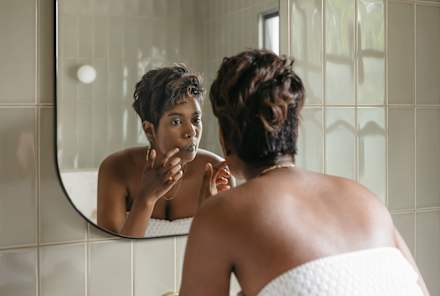Advertisement
Dom & Sub Relationships: Everything You Need To Know


When you think of a dom and sub relationship, your mind might immediately go to Fifty Shades of Grey, but there's so much more to it than what we usually see in pop culture. A dom-sub relationship is more than the whips, ropes, and role play.
What is a dom and sub relationship?
A dom-sub relationship is a common way people who are interested in BDSM and kink may choose to engage with each other. Dom is short for dominant, while sub is short for submissive. These terms describe the two roles that partners may choose to take on within a sexual (or romantic) relationship.
The best way to think of a dom-sub relationship is as "a consensual, eroticized exchange of power," a definition that was introduced by Cynthia Slater, an early leader in the SF Bay Area BDSM community, according to sexologist Carol Queen, Ph.D.
Dom and sub relationships are represented by the "DS" in the acronym BDSM, which stands for bondage and discipline, dominance and submission, and sadism and masochism. The power differential between the dom and sub is sometimes memorialized with capital and small-case letters: You will often see the acronym written D/s, Queen notes.
"BDSM can be complicated. But all those terms imply two things in particular: a person who acts on another and/or does things to them, and power exchange," Queen says.
So, a dom acts upon or does things to a sub. This is consensual and negotiated, such that the acts performed are within the sub's boundaries of what they would like to experience and within the boundaries of what the dom wishes to do. The notion of power exchange implies relative equality between the two (or more) partners, not a permanent state of inequality since you cannot exchange power if you don't have some to start with.
"Dom-sub play can involve much more than genital sex (and need not include that kind of sex at all). It can involve service, exhibitionism, the other elements of the BDSM acronym (bondage, discipline aka spanking or impact play, sadism and masochism aka eroticizing intense sensation)," Queen explains. "It can involve pretty much anything, as long as the participants want to do it and it can be contextualized in a dom-sub framework."
The role of the dom.
In a D/s relationship dynamic, the role of the dominant partner is to hold and exercise the control that the submissive has consensually transferred.
"As a dominant, you enjoy the role of being assertive and direct how the scene plays out. You can look at a D/s relationship like an exchange, between power dynamics," says sex and relationship coach Azaria Menezes. "As a dominant, your role is to lead, guide, protect, enforce, decide, etc. But most importantly, your role is to hold the space of trust and exercise control with responsibility."
Dom can also be spelled as "domme" if the dominant presents or identifies as femme.
The role of the sub.
As a submissive, your desire is in consensually agreeing to relinquish control and surrender and submit to the direction, leadership, or guidance of the dominant. Menezes says the submissive typically feels empowered by surrender and enjoys giving up control in the agreed-upon scene.
"Surrender requires trust and comes with vulnerability," she explains. "Trusting the dominant and setting clear agreements around the scene (consent, boundaries, limits, safe words, etc.) are incredibly important."
Although the dominant partner has the perceived power in the relationship, Menezes notes that the submissive can choose to end the scene or relationship at any point or use their safe word to tap out. "The dynamic of control is only in the dominant's hands until the context of the scene or relationship ends and/or if either one chooses to end the scene," she adds.
Types of dom/sub relationships.
Like other relationships, dom-sub relationships come in many configurations. These relationships can be long-term, exclusive, and romantic; long term but poly or kinky friends-with-benefits-style; or one-time things.
Queen also notes that doms are often referred to as tops, while subs are referred to as bottoms. However, it's a common myth that people are all either tops/doms or bottoms/subs; many people like to play both roles, and those people may be called switches.
Here are a few ways people may engage in dom-sub relationships:
D/s lovers
There are no whips and chains in their toy box, but there might be lots of vibrators. These people have sex the way most people do, but one partner "runs the f--k," as the charming saying goes. The sub in this scenario finds it exciting to be told to perform sexually and gets off on sexually servicing their dom, says Queen.
Master and servant
This pairing doesn't just focus on sexual service—many other types of service might be points of focus. Think of the BDSM classic: the sub caring for the dom's boots and leathers. But in a different context, this could look like laying out someone's evening clothes and helping them get ready to go out.
Bondage, D/s style
It's not unusual to see D/s partners who specialize in creating beautiful bondage harnesses or amazing suspension bondage scenarios together, Queen says.
"This kind of play could be done with a stranger—but since a substantial amount of trust needs to be involved, not to mention skill, it can be wise and pleasurable to establish a regular partner for this kind of play."
Training relationships
In these, the dom treats the sub as a kind of private student—or even as a role-play animal. "My favorite: Puppies and ponies, where the dom sets the training regimen and the sub learns sexual skills," Queen says.
Keyholders
This is a term associated with chastity play where the key in question is a key to a cock cage or chastity belt, Queen explains. This kind of D/s play involves a sub allowing their dom to tell them when they can touch themselves, have an orgasm, etc.
Caregiver/little
In these relationships, the dom acts in an older caregiver role, such as mother, father, aunt/uncle, or nanny type over a sub who plays a younger role, says Antonia Hall, transpersonal psychologist, sex educator, and author.
"Age play for the submissive may begin as a baby in diapers with a pacifier, a young child or adolescent. Activities can range from nurturing (bath time, hair brushing) to spanking and punishment. Submissives express an appreciation for being able to get out of their heads and relaxing into somebody else taking care of them," Hall explains.
24/7
Some people engage in D/s play as a permanent (unless they renegotiate) part of their relationship. Unlike most of the rest of the styles above, in these relationships the roles are generally fixed and don't involve switching, as the above styles might, says Queen.
Female-led relationships
The term female-led relationship or FLR traditionally describes an ongoing BDSM relationship between a dominant woman and a submissive man. Though as sex educator and professional dominatrix Lola Jean recently told mbg, that definition has been evolving. "FLR can be any relationship that is not 'male-led,'" she explains. "In its more extreme and perhaps traditional [form], FLR is a relationship where the female, or femme, is the decision-maker for the other partner. This could be anything from their finances to their attire to more menial tasks like chores."
Tips for exploring a dom/sub relationship:
Do your research.
To start, Queen recommends figuring out what kinds of dom-sub styles are out there, what they involve, what you might need to engage in it, and what kind of focus are you drawn to. For this step, read, attend classes, or even seek out mentors.
Figure out who you'll play with.
Who will you play with? Queen says it's important to ask this question before diving in. Do you have a partner who is likely to want to explore this? If yes, talk to them to see if you can find yourself on the same page in terms of your play style. If you don't have a partner, this is the phase when you begin to figure out where the people are who want to play this way. It's a good spot to be in because you can fine-tune your search. Queen also suggests including any potential partners in the research step.
Set boundaries and limits.
Have very clearly defined boundaries before beginning dom-sub role play. It is imperative that both the dominant and submissive sit down and go over boundaries and limits. This may include a contract detailing what the submissive is comfortable with and what is off-limits, says Hall.
Prioritize safety.
The submissive's physical, mental, and emotional safety, as well as that of the dominant, is extremely important, Hall notes. "As many dom/domme and sub relationships involve some level of bondage, discipline, caregiving, and punishment, it is the dominant's responsibility to stay clear of mind, limit drug and alcohol use during role-play, stop the role-play before getting tired, and always be aware of the submissive's state of being."
You'll also need a safe word, even if you aren't doing the kind of BDSM that requires special gear. Make sure your safe word is a word or phrase that would never come up in ordinary play, so it is immediately clear if either of you is asking the other to stop, Queen adds.
Find BDSM community.
All of this is much easier when you have role models and people around you who "get it." You can also find kink-aware therapists and other professionals, as well as online experts whose classes delve into the emotional space as well as the physical techniques of BDSM and dom-sub play.
Additional reading material.
- The Sexually Dominant Woman: A Workbook for Nervous Beginners
- Playing Well With Others: Your Field Guide to Discovering, Exploring, and Navigating the Kink, Leather and BDSM Communities
- Tongue Tied: Untangling Communication in Sex, Kink & Relationships
- Screw the Roses, Send Me the Thorns: The Romance and Sexual Sorcery of Sadomasochism
The bottom line.
Exploring BDSM, specifically a dom and sub relationship, can be an amazing experience for you and your partner or partners. However, before diving headfirst into anything, do your research and make sure you are comfortable with what will be required of you. And finally, whatever you do, make sure you're creating a safe, consensual space built on agreements and discussions that honor everyone involved.











